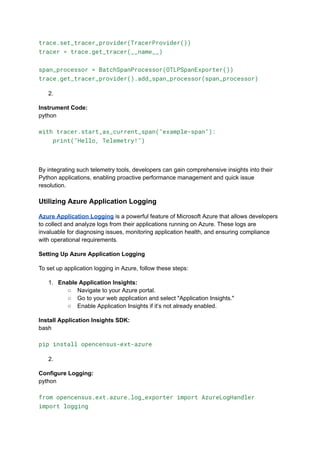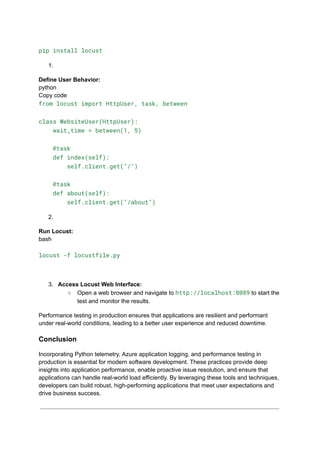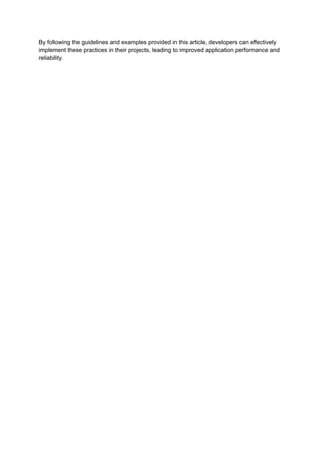Leveraging Python Telemetry, Azure Application Logging, and Performance Testing in Production for Enhanced Application Performance.pdf
- 1. Leveraging Python Telemetry, Azure Application Logging, and Performance Testing in Production for Enhanced Application Performance In today's fast-paced digital landscape, ensuring the reliability, performance, and observability of applications is crucial. This involves leveraging tools and techniques such as Python telemetry, Azure application logging, and performance testing in production. These practices help in monitoring application health, diagnosing issues, and optimizing performance, ultimately leading to a better user experience and more robust applications. In this article, we'll explore these concepts in detail and understand how they can be effectively implemented. Understanding Python Telemetry Python telemetry refers to the collection, processing, and analysis of data from Python applications to monitor their performance and behavior. This data includes metrics, logs, traces, and other relevant information that provides insights into the application's internal state. Telemetry is essential for identifying performance bottlenecks, detecting anomalies, and ensuring the overall health of an application. Implementing Python Telemetry To implement telemetry in Python applications, developers can use various libraries and frameworks. One popular choice is the OpenTelemetry library, which provides a standard way to collect telemetry data. Here’s a brief overview of how to set up OpenTelemetry in a Python application: Install OpenTelemetry: bash pip install opentelemetry-api pip install opentelemetry-sdk pip install opentelemetry-exporter-otlp 1. Initialize the Tracer: python from opentelemetry import trace from opentelemetry.sdk.trace import TracerProvider from opentelemetry.sdk.trace.export import BatchSpanProcessor from opentelemetry.exporter.otlp.trace_exporter import OTLPSpanExporter
- 2. trace.set_tracer_provider(TracerProvider()) tracer = trace.get_tracer(__name__) span_processor = BatchSpanProcessor(OTLPSpanExporter()) trace.get_tracer_provider().add_span_processor(span_processor) 2. Instrument Code: python with tracer.start_as_current_span("example-span"): print("Hello, Telemetry!") By integrating such telemetry tools, developers can gain comprehensive insights into their Python applications, enabling proactive performance management and quick issue resolution. Utilizing Azure Application Logging Azure Application Logging is a powerful feature of Microsoft Azure that allows developers to collect and analyze logs from their applications running on Azure. These logs are invaluable for diagnosing issues, monitoring application health, and ensuring compliance with operational requirements. Setting Up Azure Application Logging To set up application logging in Azure, follow these steps: 1. Enable Application Insights: ○ Navigate to your Azure portal. ○ Go to your web application and select "Application Insights." ○ Enable Application Insights if it’s not already enabled. Install Application Insights SDK: bash pip install opencensus-ext-azure 2. Configure Logging: python from opencensus.ext.azure.log_exporter import AzureLogHandler import logging
- 3. logger = logging.getLogger(__name__) logger.addHandler(AzureLogHandler( connection_string='InstrumentationKey=your_instrumentation_key')) logger.warning('This is a warning message.') 3. View Logs in Azure Portal: ○ Once the logging is configured, you can view and analyze the logs in the Azure portal under Application Insights. Azure Application Logging provides rich insights into application performance and behavior, helping developers identify and fix issues quickly and efficiently. Performance Testing in Production Performance testing in production is a practice where applications are tested for performance issues in a live environment. This approach helps in identifying real-world performance bottlenecks and ensuring that the application can handle actual user load. Best Practices for Performance Testing in Production 1. Use Realistic Load: ○ Simulate realistic user traffic to understand how the application performs under actual load conditions. 2. Monitor Key Metrics: ○ Track important performance metrics such as response time, throughput, error rates, and resource utilization. 3. Automate Testing: ○ Use automation tools to regularly perform performance tests. Tools like JMeter, Locust, and Gatling can be used for this purpose. 4. Analyze Results: ○ Analyze the test results to identify performance bottlenecks and areas for improvement. 5. Implement Continuous Testing: ○ Integrate performance testing into the CI/CD pipeline to ensure that performance is continuously monitored and optimized. Example: Performance Testing with Locust Locust is an open-source load testing tool that allows developers to define user behavior in Python code. Here’s a simple example of how to use Locust for performance testing: Install Locust: bash
- 4. pip install locust 1. Define User Behavior: python Copy code from locust import HttpUser, task, between class WebsiteUser(HttpUser): wait_time = between(1, 5) @task def index(self): self.client.get("/") @task def about(self): self.client.get("/about") 2. Run Locust: bash locust -f locustfile.py 3. Access Locust Web Interface: ○ Open a web browser and navigate to http://localhost:8089 to start the test and monitor the results. Performance testing in production ensures that applications are resilient and performant under real-world conditions, leading to a better user experience and reduced downtime. Conclusion Incorporating Python telemetry, Azure application logging, and performance testing in production is essential for modern software development. These practices provide deep insights into application performance, enable proactive issue resolution, and ensure that applications can handle real-world load efficiently. By leveraging these tools and techniques, developers can build robust, high-performing applications that meet user expectations and drive business success.
- 5. By following the guidelines and examples provided in this article, developers can effectively implement these practices in their projects, leading to improved application performance and reliability.





